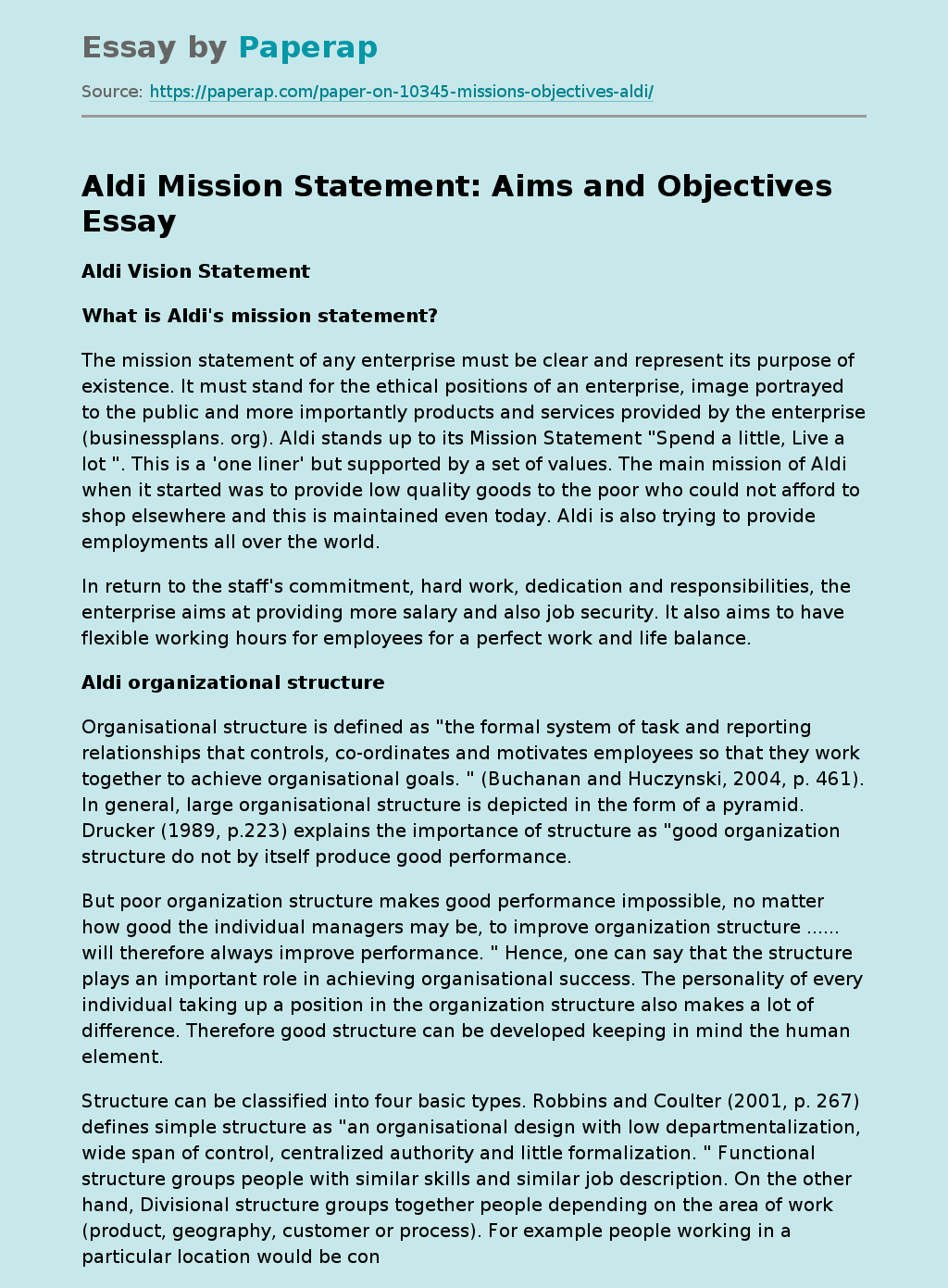Aldi Mission Statement: Aims and Objectives
Aldi Vision Statement
What is Aldi’s mission statement?
The mission statement of any enterprise must be clear and represent its purpose of existence. It must stand for the ethical positions of an enterprise, image portrayed to the public and more importantly products and services provided by the enterprise (businessplans. org). Aldi stands up to its Mission Statement “Spend a little, Live a lot “. This is a ‘one liner’ but supported by a set of values. The main mission of Aldi when it started was to provide low quality goods to the poor who could not afford to shop elsewhere and this is maintained even today.
Aldi is also trying to provide employments all over the world.
In return to the staff’s commitment, hard work, dedication and responsibilities, the enterprise aims at providing more salary and also job security. It also aims to have flexible working hours for employees for a perfect work and life balance.
Aldi organizational structure
Organisational structure is defined as “the formal system of task and reporting relationships that controls, co-ordinates and motivates employees so that they work together to achieve organisational goals.
” (Buchanan and Huczynski, 2004, p. 461). In general, large organisational structure is depicted in the form of a pyramid. Drucker (1989, p.223) explains the importance of structure as “good organization structure do not by itself produce good performance.
But poor organization structure makes good performance impossible, no matter how good the individual managers may be, to improve organization structure …… will therefore always improve performance. ” Hence, one can say that the structure plays an important role in achieving organisational success.
The personality of every individual taking up a position in the organization structure also makes a lot of difference. Therefore good structure can be developed keeping in mind the human element.
Structure can be classified into four basic types. Robbins and Coulter (2001, p. 267) defines simple structure as “an organisational design with low departmentalization, wide span of control, centralized authority and little formalization. ” Functional structure groups people with similar skills and similar job description. On the other hand, Divisional structure groups together people depending on the area of work (product, geography, customer or process). For example people working in a particular location would be considered a group under geographic divisional structure.
Finally, the Matrix structure utilizes the benefits of the above two types to from groups based on projects. The group members in this type would generally belong to at least two formal groups. (Schermerhorn, 2001). LearnManagement2. com (2010) defines the term Span of control as “the term used to describe the number of employees that each manager is responsible for. ” It can also be noticed (as depicted in the following diagram) that having a broader span of control results in a flat structure and a narrow span of control leads to the formation of a tall organization structure.
Figure: Flat and Tall Organisational structures. (source: http://www. bbc. co. uk/schools) In the above figure organisation A represents tall-structure and organisation B represents flat structure. Robbins and Coulter, (2001, p. 260) defines Chain of Command as”The continuous line of authority that extends from upper organisational levels to the lowest levels and clarifies who reports to whom. ” Authority, responsibility and unity of command together ensure the effective functioning of the chain of command. The right to command sub-ordinates and expect the work to be done is known as authority.
In the same way the obligation to perform any assigned tasks is called responsibility. When every member of the organisation takes orders and reports to only one person, it is known as unity of command. These keywords and their definitions have been adopted from Robbins and Coulter (2001). Aldi follows a divisional structure based on geography, without being too departmentalized. The divisional managers are completely responsible for handling the services/products provided by the store and running the store as if it were his/her own business.
This also indicates that Aldi follows a decentralized structure where-in lower level managers are skilled and capable of making decisions all by themselves. As a part of decentralization which happened when Aldi was split into Aldi Nord and Aldi Sud in 1961, an autonomous corporation was formed for every sixty to eighty stores in the locality. This lead to the formation of a large number of autonomous corporations, which competed with each other in a healthy fashion to help the growth of the organisation.
In a geographically dispersed organisation like Aldi this has proved to be a good decision considering the growth and success of Aldi ever since its formation. Due to the small size of the corporations there will be less bureaucracy and almost all issues can be handled at ground-level quickly using the knowledge of the local market. Decentralised structure of Aldi allows regional managers to involve in decision making and also helps effective implementation of the company’s strategies. These views of a decentralised structure have been adapted from Robbins and Coulter (2001).
Aldi’s structure is a flat one when defined in terms of span of control. The Managers have a wide span of control, thus leading to a flat structure rather than a hierarchical one. Aldi does not have separate planning, human resources, public relations or marketing departments. Managers have clear specifications for goals, responsibilities and authority. It is the manager’s job to delegate these to the sub-ordinates in an efficient and clear manner. Random checks and evaluation of performance and results is done to maintain the culture and exercise authority.
Aldi Mission Statement: Aims and Objectives. (2017, Dec 09). Retrieved from https://paperap.com/paper-on-10345-missions-objectives-aldi/

